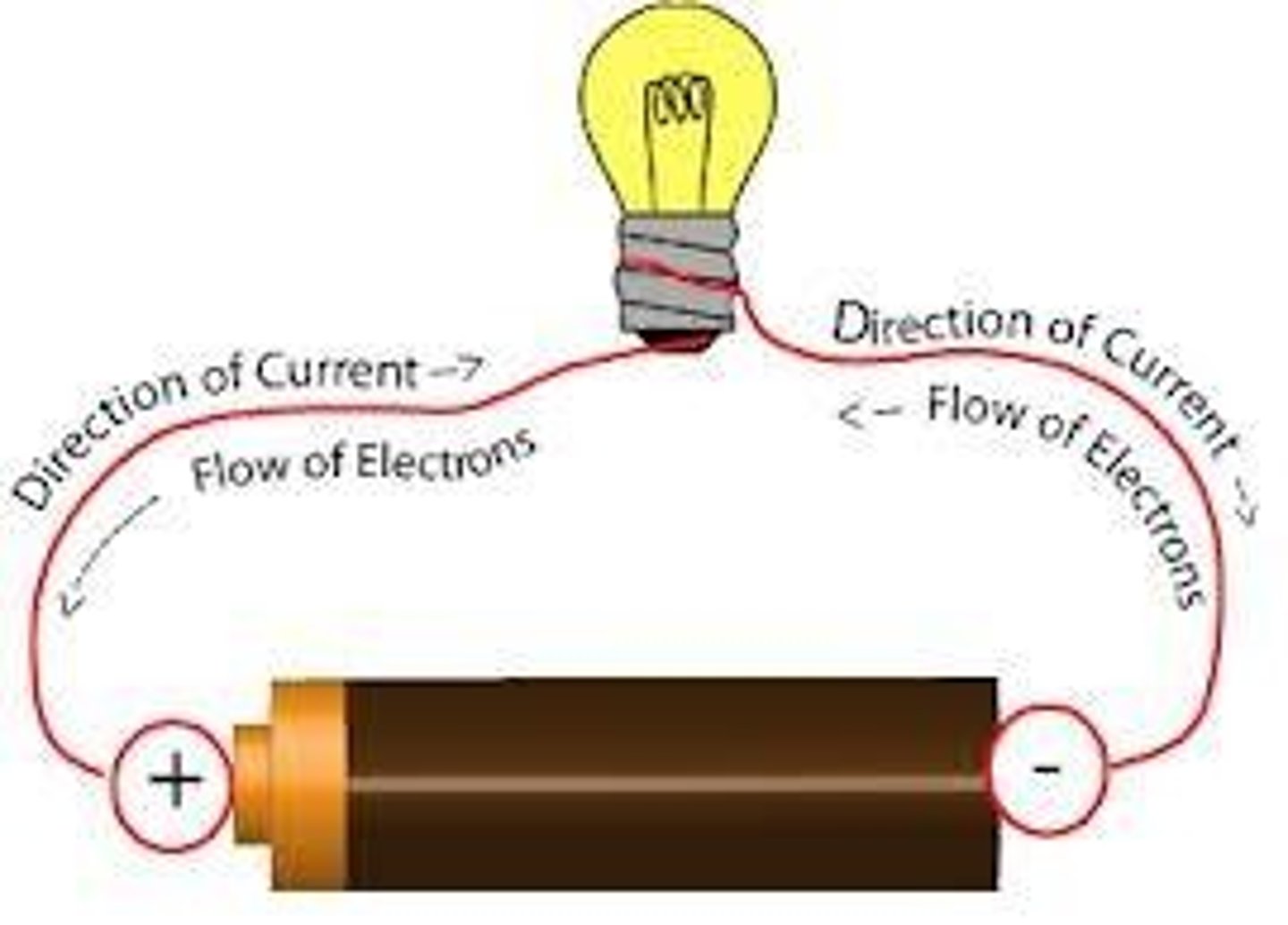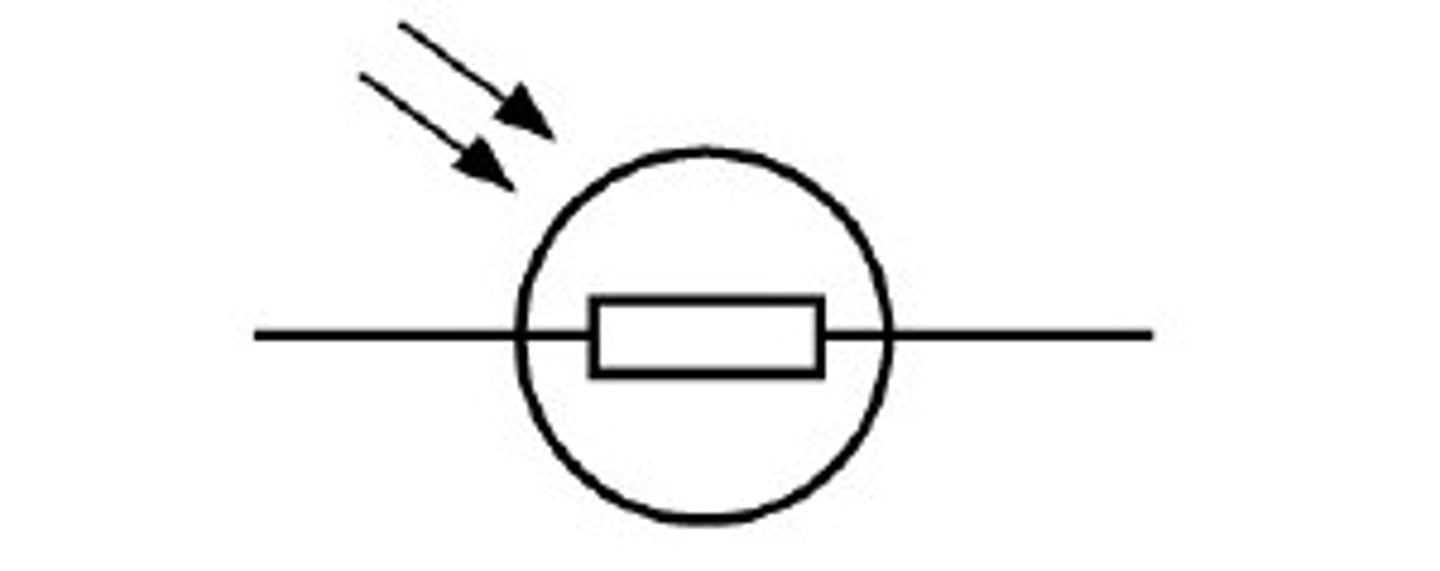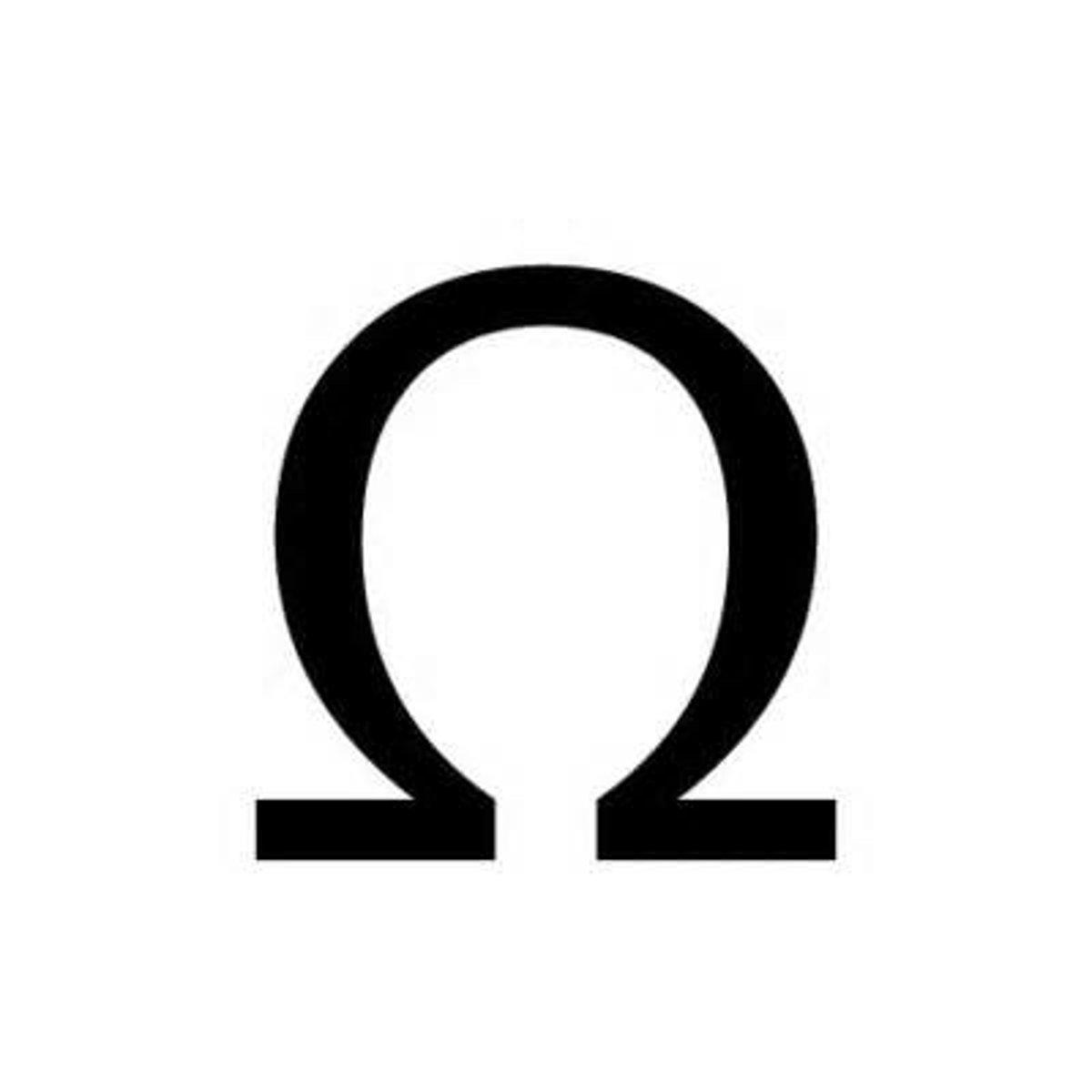A Level Physics- Electricity
1/84
There's no tags or description
Looks like no tags are added yet.
Name | Mastery | Learn | Test | Matching | Spaced |
|---|
No study sessions yet.
85 Terms
Ampere
The base SI unit of electric current. (A)

Conservation of Charge
A conservation law which states that electric charge can neither be created nor destroyed- the total charge in any interaction must be the same before and after the interaction.

Conventional Current
A model used to describe electric current in a circuit- conventional current travels from positive to negative (the direction that positive charges would travel).
Coulomb
The derived SI unit of electrical charge. I coulomb of electric charge passes a point I. one second when there is an electric current of 1 Ampere.
1 C = 1 A s
Diode
A semi conductor component that allows current to flow in only one direction.

Electric Charge
A physical property, symbol q or Q, it could be either positive or negative, which is measured in Coulombs.
Electric Current
The rate of flow of charge, measured in Amperes. Normally a flow of electrons in metals or a flow of ions in electrolytes.

Electromotive Force
Defined as the energy transferred from chemical to electrical energy per unit charge.
Elementary Charge
The electric charge equivalent to the charge on a proton, 1.60x10^-19 C.
Internal Resistance
The resistance of a source of emf due to its construction, which causes a loss in energy or voltage as the charge passes.
Kirchhoff's First Law
At any point in an electrical circuit, the sum of the emf's is the equal to the sum of the pd's.
Light Dependent Resistor (LDR)
An electrical component with a resistance that decreases as the light intensity on it increases.

Lost Volts
The potential difference across the internal resistor of a source of emf.
Main Drift Velocity
The average velocity of electrons as they move through a wire.
Non-Ohmic Component
A component that does not obey Ohm's law.
Ohm's Law
The potential difference across a conductor is directly proportional to the current in the component as long as its temperature stays constant.

Ohmic Conductor
A conductor that obey Ohm's law.
Ohm
The derived SI unit of resistance defined as the resistance of a component that has a potential different of 1v per unit ampere.

Potential Difference
Defined as the energy transferred from electrical energy to other forms per unit charge.
Potential Divider
An electrical circuit designed to divide the potential difference across two or more components in order to produce a specific output.
Resistance
A property of a component calculated by dividing the potential difference across it by the current in it. Symbol R.
Resistivity
A property of a material, measured in ohmmeter, defined as the product of the resistance of a component made of the material and its cross sectional area divided by its length.
Resistor
An electrical component that obeys Ohm's law, transferring electrical energy to thermal energy.
Semiconductor
A material with a lower number density than a typical conductor.
Thermistor
An electrical component that has a resistance that decreases as the temperature increases, (negative temperature coefficient).
Voltmeter
A device used to measure potential difference- it must be placed in parallel across components and ideally have an infinite resistance.
charge carriers in metal conductor
conduction electrons- delocalised electrons. When volatage is applied across metal conduction electrons re attracted to positive terminal of metal
charge carriers in salt solution
ions -charged atoms or molecules
charge equation
Q=IT
charge carriers in insulator
each electron attatched to an atom and cant move
when voltage is applied no current passes because no electrons can move
charge carriers in semiconductor
number of charge carriers increases with temp. resistance of semiconductor decreases as temp rises.
intrinsic semiconductor
pure semiconducting material as conduction is due to electrons that break free ffrom atoms of semiconductor
potential difference
work done by an electron er unit charge
work done = loss of energy of electron
equation for potential difference (V,W,Q)
V=W/Q
W=QV
emf
emf of a source of energy is the electrical energy produced per unit charge passing through the source
UNIT: volt
for source, e, the electrical energy produced when Q passes through source =Qe
Why do some objects heat up when electricity is passed through them>
electric current has heating effect when passing through component with resistance, work done in device is transferred as thermal energy.
-> charge carriers repeatedly collide with atoms in device and transfer KE so atoms vibrate more and resistors become hotter
energy transfer in electric motor turning at constant speed
work done on motor=energy transferred to load and surroundings by motor, KE of motor remains constant
charge carriers are electrons that need to be forced through wires of spinning motor coil agains opposing force on electrons due to motors magnetic field
loudspeaker energy transfer
work done=sound energy
electrons need to be forced through wires of vibrating loudspeaker coil against force on them due to electromagnet in loudspeaker
electrical power equation
P=IV
work done electric
W=IV(change in) t
resistance of any component
pd across the component/ the current through it
resistance equation
R=V/I
graph for resistor
straight line through origin, resistance is the same regardless of current
pd across resistor is proportional to current
ohms law
pd across a metallic conductor is proportional to the current through it, provided physical conditions do not change
Resistivity equation
p=RA/L
A= cross sectional area
A=((pi)d^2)/4
p= constant for that material (UNIT: Ohm meter)
resistance relationship with length and area
R= proportional to L
r=inversely proportional to A
graph of resistance against length of wire
y axis= change in R
x axis= change in L
resistivity of wire is gradient of graph xA
superconductor
wire or device made of material with zero resistivity and below a critical temp that depends on the material .
when current passes through it, there is no pd because resistance is zero. therefore current has NO HEATING EFFECT
when a superconductor is raised above its critical temperature
the superconductor loses its superconductivity
high temperature superconductor
any material with a critical temperature above 77K
uses of superconductors
used to make high power electromagnets that generate v high magnetic fields in devices such as MRI scanner and particle acceleratprs
Also used in developments of new applications such as lightweight electric motors and power cables that transfer electrical energy without energy loss.
diode
allows current in one direction only
Light emitting diode
emits light when it conducts.
uses of diodes
protection of DC circuits, to prevent current flowing the wrong way
thermistor
resistance of a thermistor decreases with increasing temp, if the thermistor is an intrinsic semiconductor e.g. silicon
light dependent resistor
resistance decrease with increasing light intensiy
how to measure the variation of current with pd for a compondent
use either a potential divider to vary the pd from zero
variable resistor to vary current to a minimum
benefits of using a potential divider when measuring the variation of current with pd for a component
you can vary pd and current from 0. Not possible with variable resistor
graph of current and pd
y axis- current
x axis- pd
how can you capture data in a circuit
use an ammeter sensor and voltmeter sensor connected to a data logger used to capture data (ie to measure and record the readings) which could be displayed directly onto an oscilloscope or computer
current pd graph for wire
straight line through origin. Any point on the line v/i is the same.
grad= 1/resistance
at constant temp
current pd graph for filament bulb
curve with decreasing gradient because resistance increases as it gets hotter.
current pd graph for thermistor
at constant temp gives a straight line
higher the temp- the greater the grad of line as resistance falls with increase in temp.
same result as LDR with light intensity
why does resistance of a . metal increase with increase in temp?
positive ions in conductor vibrate more when temp is increased to to increased KE. The charge carriers therefore cannot pass through the metal as easily when a pd is applied accross the conductor
positive temperature coefficient
a metal has a positive temperature coefficient because its resistance increases with increase of temp
effect of temp on resistance of intrinsic semiconductor
Why?
resistance of intrinsic semiconductor decreases with increase in temp because number of charge carriers increase when temp is increased.
thermistor made from an intrinsic semiconductor has what temp coefficient?
negative temp coefficient. Its % change of resistance per kelvin change of temp is much greater than for a metal. For this reason thermistors are often used as temperature sensitive component in a temperature sensor.
why are thermistors are often used as temperature sensitive component in a temperature sensor.
Its % change of resistance per kelvin change of temp is much greater than for a metal.
components in series
A= stays the same
potential drop and rise
if charge carriers lose energy the pd is a potential drop
if they gain energy (when they pass cell) the pd is an potential rise equal to pd across cells terminals
components in series - Pd
v1+v2+v3=v0
components in parallel -pd
same
loop rule pd and emf
for any complete loop of a circuit the sum of the emfs round the loop is equal to the sum of potential drops around the loop
conservation of energy
components in series- resistance
total R =sum of individual resistances
components in parallel- resistance
1/R=1/R1+1/R2+1/R3
rate of heat transfer
I^2 R
resistance heating
charge carriers repeatedly collide with +ions of conducting material . Net transfer of energy from charge carriers to positive ions due to collisions. After a charge crrier loses KE the force due to pd across material accelerates it until it collides with another + ion
ENergy transferred equation
I^2Rt
energy transferred per second to the component does not depend on direction of current
Internal resistance
loss of potential difference per unit current in the source when current passes through the source
due to opposition to the flow of charge through the source, causing electrical energy produced by the source to be dissapated inside the source when charge flows through it
electromotive force (emf) of the source
the electrical energy per unit charge produced by the source
emf equation
emf=E/Q
current through cell equation
emf=IR+Ir
R= external resistor
r= internal resistance
lost pd in cell
equal to the difference between the cells emf and the pd across its terminals
energy terms: lost pd is the energy per coulomb wasted inside the cell due to its internal resistance
power supplied by the cell, I emf
I^2R+I^2r
when is maximum power delivered to the load?
when the load resistance is equal to the internal resistance of the source